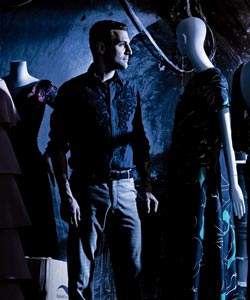 |
|
1. PAUL POIRET (1879-1944)Paul Poiret (1879-1944) “I had fallen in love with this dress years before when I saw it in a textbook. Poiret is the father of modern fashion, and this was his signature piece.” 2. ELSA SCHIAPARELLI (1890-1973)“Elsa was very good friends with Salvador Dali and Jean Cocteau. Cocteau made this witty drawing that was translated onto the dress by the embroidery firm Lesage.” 3. CHARLES JAMES(1906-1978)“James’s mother came from a prominent Chicago Family, and he began his career as a milliner on State Street. This gown is maed of 25 yards of peau de soie and nylon netting.” 4. YVES SAINT LAURENT for Christian Dior (1936-2008)“This dress is such a departure from everything Christian Dior did. It’s a precursor for the youth quake that happened in the 1960s.” |
Tim Long can tell you that Poiret’s sorbet dress from 1913 was one of the most important designs of the 20th century. He can also tell you why: Because of its loose form, the dress is usually credited with marking the transition from corsets to less con-straining modernity. He can tell you how many of these dresses exist in the world—three. But the fact he might be happiest to share is that one of those dresses (the design is often featured in fashion history books) belongs to the Chicago History Museum, where Long, 32, is the costume curator. After a recent showing at the Metropolitan Museum of Art and the Fashion Institute of Technology in New York, the Poiret sorbet dress will finally make its Chicago debut when the Chic Chicago exhibition opens at the history museum this month.
 |
The museum turns out to have one of the largest collections of historical clothing—fourth or fifth in the world, including lots of blue-chip signature pieces such as a Schiaparelli Jean Cocteau dress, a Saint Laurent trapeze dress, and a Balenciaga waterfall coat. "For a while, the general public didn’t know we had these things," Long says. "That’s our fault." The museum has recently added a new permanent costume and textile gallery.
Long and his museum colleagues are hoping this exhibition will draw big crowds. Knowing the story behind a dress makes it that much more interesting and accessible to non–fashion buffs. "When other museums do a Balenciaga retrospective, often the dress comes from the house archives and was never worn," Long says. That’s not the case with the donated clothes at the Chicago History Museum. "We know the history behind every one of our pieces, so we try to highlight that," he explains. Tone is important, too. Long, who teaches at the School of the Art Institute of Chicago, believes that academic descriptions can be a hindrance when talking about fashion. "Fashion is just fashion—something we all wear," he says.
Long had always dreamed of mounting a "best of the best" of the museum’s collection, but the realization came about only in July 2007 after a lunch with FIT curator Valerie Steele in New York. "It wasn’t a pitch; we were just two colleagues talking, but her eyes started getting big when I described how much couture we had. When another exhibit she was planning got canceled soon after, she called and asked if I was serious about doing this exhibition. Then she asked if we could do it at FIT first." Which is what led Long to co-curate his dream show in just a few months. By October the exhibit was ready to go, and it received a strong reception.
When the exhibition opens in Chicago on September 27th, it will focus more on the lives of those who wore the designs than the New York show. In preparation, Long has been researching the owners’ diaries and calling descendants. When I visited the museum, he was padding mannequins so that the clothes would fall as they did on the bodies of the women who wore them. When Long shows me the dress form used to represent Mary Todd Lincoln, I ask if she had a 17-inch waist like Scarlett O’Hara. "No, it was 19 in early life, and 23 or 24 later," he says, grinning.
Long shares his theory on why the collection became so strong: "It’s funny that we have so many signature pieces," he says. "I’ve started interviewing women to find out why. It seems the Second City reputation goes back to the city’s beginnings. These women used dress to prove their sophistication in international social circles. If they were going to buy Balenciaga, they bought the Balenciaga of the season."
So what’s the story behind the Poiret sorbet dress? Turns out it was worn by Anita Carolyn Blair, the granddaughter of the founder of the Merchants National Bank, at a debutante ball. The slinky silhouette caused quite a stir: "I would love to have been in that room full of corsets when she walked in."
Photography:(Long) Anna Knott, (dresses) Courtesy of The Chicago History Museum


